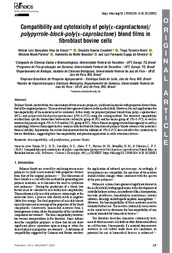Compatibility and cytotoxicity of poly(?-caprolactone)/ polypyrrole-block-poly(?-caprolactone) blend films in fibroblast bovine cells.
Compatibility and cytotoxicity of poly(?-caprolactone)/ polypyrrole-block-poly(?-caprolactone) blend films in fibroblast bovine cells.
Author(s): SOUZA, N. L. G. D. de; CAVALLINI, G. S.; ALVES, T. T.; PEREIRA, M. M.; BRANDAO, H. de M.; OLIVEIRA, L. F. C. de
Summary: Polymer blends, derived from the combination of two or more polymers, yield novel materials with properties distinct from that of the original polymers. These materials have garnered interest in the medical field. However, for such applications the biocompatibility of the material must be evaluated. In this study, we prepared polymer blends from poly(?-caprolactone) (PCL) and polypyrrole-block-poly(caprolactone) (PPy-b-PCL) using the casting method. The observed compatibility resulted from specific interactions between the carboxylic group of PCL and the amine group of PPy-b-PCL, as well as between the pyrrole ring of PPy-b-PCL and the CH2 group of PCL. Micro-Raman imaging revealed homogeneity in surface morphology, whereas thermogravimetric analysis indicated that the formation of polymer blends enhances the material’s thermal stability. Importantly, the results demonstrated that the addition of PPy-b-PCL does not affect the cytotoxicity to bovine fibroblasts, suggesting their biocompatibility and potential application in cattle veterinary devices.
Publication year: 2024
Types of publication: Journal article
Unit: Embrapa Dairy Cattle
Observation
Some of Embrapa's publications are published as ePub files. To read them, use or download one of the following free software options to your computer or mobile device. Android: Google Play Books; IOS: iBooks; Windows and Linux: Calibre.
Access other publications
Access the Agricultural Research Database (BDPA) to consult Embrapa's full library collection and records.
Visit Embrapa Bookstore to purchase books and other publications sold by Embrapa.

